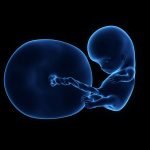Reducing Childhood Asthma Risk
Bianca Garilli, ND
Vis Medicatrix Naturae
Prenatal Omega-3 Fatty Acid Supplementation
The prevalence of asthma in the United States has increased from 7.3% of the population in 2001 to 8.4% in 2010. In 2010, there were an estimated 7 million children between the ages of 0 and 17 years who had been diagnosed with asthma and still had the condition. In the same year, asthma prevalence was at an all-time high and the numbers have continued to climb.1 According to the 2014 Global Asthma Report, 14% of the world’s children experience asthma symptoms and the greatest asthma burden lies on people between 10–14 and 75–79 years of age.2 Clearly, children are being heavily impacted with this condition, which includes a life-long course of chronic symptomatology.
Both genetics and environment play a risk in the development of asthma in children. Estimates of asthma heritability (the proportion of total variation between individuals in a given population due to genetic variation) vary, ranging from 35% to 95%.3 It is important to note that heritability is a characteristic of a group, and does not reflect individual risk of inheritance.4
There are myriad environmental and lifestyle risk factors for asthma: Indoor allergens (in some cultures, this includes cooking on indoor open fires), exposure to dampness and molds, outdoor air pollutants (in particular, areas of heavy traffic and smog), and other inhaled toxins (such as second-hand cigarette smoke) all increase the risk of developing asthma. Other potential risk factors include reduced exposure to farm animals and pets, reduction in microbial exposure during childhood (as per the hygiene hypothesis, and exemplified by variations in microbial exposure during vaginal versus C-section births), and early infant and childhood use of antibiotics and acetaminophen. Nutritional status and metabolic factors of both mother and child are also important, including maternal obesity, vitamin D status, and medication use.2,3,5,6
It becomes clear, after taking in the above information, that the development of asthma is complex and multi-factorial.
One factor that can influence asthma development is the impact of the mother’s diet on the developing fetus’ future health and disease risk. For the purpose of this article, we will focus on recent information published regarding omega-3 fatty acids (n-3 FAs) during pregnancy and the subsequent reduction in risk of developing asthma during childhood.
The Latest Research
A December 2016 article published in the New England Journal of Medicine entitled “Fish Oil-Derived Fatty Acids in Pregnancy and Wheeze and Asthma in Offspring” followed over 700 pregnant women starting at 24 weeks of gestation and continuing through the first 3 to 5 years of their children’s lives. Based on previous data indicating that a reduction of n-3 long-chain polyunsaturated fatty acids (LCPUFAs) may contribute to wheezing in individuals, the study was designed to assess whether supplementing with n-3 LCPUFAs during pregnancy would reduce the risk of future development of wheezing disorders in childhood. In this double-blind study, including the follow up period, women received either 2.4 grams of fish oil QD as the n-3 LCPUFA therapeutic supplement or the same amount of olive oil as the placebo. The investigators monitored the children for the primary endpoint of persistent wheeze or asthma, as well as secondary endpoints including lower respiratory tract infections, asthma exacerbations, eczema, and allergic sensitization.7
At the end of the study period, it was found that children whose mothers supplemented with fish oil had a 30.7% relative risk reduction for the primary endpoint of wheeze or asthma, and a 25% reduction in risk of lower respiratory tract infections was also noted. The study’s authors concluded, “Supplementation with n-3 LCPUFA in the third trimester of pregnancy reduced the absolute risk of persistent wheeze or asthma and infections of the lower respiratory tract in offspring by approximately seven percentage points, or one third.” The authors went on to recommend further research, as the dosage used in this study was much higher than is currently recommended in pregnancy by most of the world’s health organizations (Table 1).7
Table 1: Examples of global and country recommendations for n-3 fatty acids or EPA and DHA intake during pregnancy.8
| International Society for the Study of Fatty Acids and Lipids (ISSFAL) | DHA: 200 mg/day |
| German Society for Nutrition | DHA: ≥ 200 mg/ day |
| Health Council of the Netherlands | N-3 FAs from fish: 20 mg/kg/day
(equivalent to about 1,400 mg/d for a 150 pound pregnant woman) |
| Italian Ministry of Health | Vegan women should consume foods rich in DHA |
| Institute of Medicine (USA) | N-3 FAs: 1.1 grams/d, of which ~ 10% should be EPA+DHA, for all women over 19 years old (No specific recommendations for pregnancy) |
| USDA and USHHS (USA) | Consume 8 to 12 ounces of a variety of seafood per week |
| Ministry of Health, Labour and Welfare (Japan) | N-3 FAs: 1.9 grams/d |
| European Food Safety Authority | EPA+DHA: 250 mg/d of EPA+DHA plus 100-200 mg/d additional DHA |
Omega-3 Fatty Acid Chemistry
As a quick refresher, the essential n-3 FA is alpha-linolenic acid (ALA), a long-chain polyunsaturated fatty acid that is essential because it must be obtained through the diet. ALA is at the top of the omega-3 fatty acid synthesis pathway and is found in plant oils such as nut and seed oils. Through a series of enzymatic reactions, beginning with one catalyzed by delta-6 desaturase, this LCPUFA is converted to EPA, and subsequently DHA. However, EPA and DHA can also be obtained directly through consumption of various foods, such as, but not limited to, marine animals and their oils and grass-fed land animals and their food products. Various genetic and environmental factors may limit the ability to convert ALA into EPA and DHA and thus many organizations and healthcare experts support the recommendation of direct supplementation or food consumption of EPA and DHA over ALA when focusing on the health benefits obtained through appropriate levels of these LCPUFAs.
The health benefits attributed to the n-3 LCPUFAs EPA and DHA during pregnancy are summarized in a 2014 article published in the European Journal of Nutrition. These benefits include supporting healthy fetal visual and neurological development, and reducing risk factors associated with preeclampsia and perinatal depression in expectant mothers.9
The downstream prostaglandin and leukotriene products from EPA and DHA are anti-inflammatory in nature and have recently been found to have additional therapeutic benefits in a variety of disease conditions due to their contribution as substrates for the formation of pro-resolving mediators. An article entitled “Fish Oil Supplementation in Pregnancy,” published in the New England Journal of Medicine in December of 2016, noted that 2 types of pro-resolving mediators that occur in the placenta and human milk, resolvins and protectins, have been found in preclinical studies to decrease airway inflammation, mucus metaplasia, and hyper-reactivity, and promote immune protection against respiratory infection. Furthermore, the article pointed to research in which airway mucosal levels of n-3 LCPUFAs were found to be lower in patients with asthma than in those without asthma.10
Babies who are nursed likely receive the benefits of these pro-resolving mediators, the levels of which may very well be dependent upon how much EPA and DHA have been consumed directly or converted from ALA by the mother during pregnancy and eventually expressed in breastmilk. It seems fair to say that the greater the breastmilk levels of EPA and DHA are, the higher the anti-inflammatory benefits for the child, including reduction in risk of developing asthma in later years. Plainly, more studies using dosages higher than the current recommended maternal intake levels for n-3 FAs are needed in order to fully support this therapeutic outcome. In the meantime, it is important to utilize the current therapeutic recommendations for pregnant women from the organizations listed in the table above to reduce the risk of future inflammatory conditions such as asthma in children.
[References]
- Akinbami L, Moorman J, Bailey C, et al. Trends in Asthma prevalence, health care use, and mortality in the United States, 2001-2010. NCHS Data Brief 2012;(94):1–8. https://www.cdc.gov/nchs/data/databriefs/db94.pdf. Published 05/2012. Accessed 01/25/2017
- Global Asthma Report 2014. Global Asthma Network. http://www.globalasthmareport.org/resources/Global_Asthma_Report_2014.pdf. Published 2014. Accessed 01/25/2017.
- Ober C, Yao T. The genetics of asthma and allergic disease: A 21st century perspective. Immunol Rev. 2011; 242(1):10–30.
- Indiana University, Bloomington. http://www.indiana.edu/~p1013447/dictionary/herit.htm. Accessed 01/25/2017
- Garilli B. Balancing the Farm Effect and the Hygiene Hypothesis. Natural Path. http://thenatpath.com/body/autoimmune/balancing-the-farm-effect-and-the-hygiene-hypothesis/. Published 06/24/2015. Accessed 01/25/2017.
- Bloomfield S, Stanwell-Smith R, Crevel R, Pickup J. Too clean, or not too clean: the hygiene hypothesis and home hygiene. Clin Exp Allergy. 2006; 36(4):402–425.
- Bisgaard H, Stockholm J, Chawes B, et al. Fish oil-derived fatty acids in pregnancy and wheeze and asthma in offspring. N Engl J Med. 2016;375(26):2530–2539.
- Global Recommendations for EPA and DHA Intake. Global Organization for EPA and DHA Omega-3. http://goedomega3.com/index.php/files/download/304. Last updated 04/16/2014. Accessed 1/25/2017
- De Giuseppe R, Roggi C, Cena H. n-3 LC-PUFA supplementation: effects on infant and maternal outcomes. Eur J Nutr. 2014;53(5):1147–1154.
- Ramaswami R, Serhan C, Levy B, Makrides M. Fish oil supplementation in pregnancy. N Engl J Med. 2016;375(26):2599-2601.
 Bianca Garilli, ND, is a former US Marine turned ND. She received her BS in Biology from the University of Maryland and her ND from Bastyr University. In addition to working with patients to create personalized lifestyle medicine programs, she also consults with medical practices and with nutraceutical companies in a variety of professional educational capacities. She is on the faculty of Hawthorn University and is a founding board member and current President of the California Chapter of the Children’s Heart Foundation. Dr Garilli lives in beautiful Northern California with her husband, their two (very) active children and four backyard chickens.
Bianca Garilli, ND, is a former US Marine turned ND. She received her BS in Biology from the University of Maryland and her ND from Bastyr University. In addition to working with patients to create personalized lifestyle medicine programs, she also consults with medical practices and with nutraceutical companies in a variety of professional educational capacities. She is on the faculty of Hawthorn University and is a founding board member and current President of the California Chapter of the Children’s Heart Foundation. Dr Garilli lives in beautiful Northern California with her husband, their two (very) active children and four backyard chickens.










